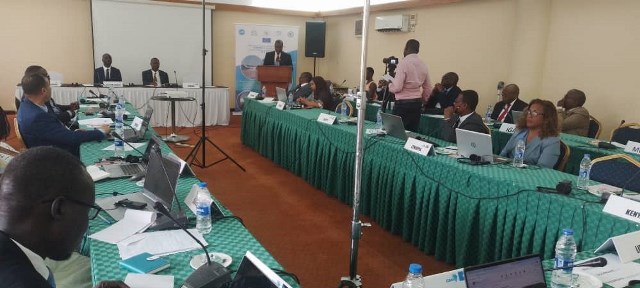Uganda hints at SAATM join date as Kampala hosts COMESA workshop on alignment of BASAs with Yamoussoukro Decision

Michael Wakabi
Uganda expects to sign up to the Single African Air Transport Market SAATM in the coming months, following the conclusion of internal stakeholder consultations and the harmonisation of its legal and regulatory framework, with the provisions and spirit of the Yamoussoukro Decision.
The development was revealed by Mr. Fred Byamukama, the junior minister responsible for transport in the Ministry of Works and Transport. Byamukama further said Uganda would accede to the SAATM treaty early in fiscal 2024-25, which starts on July 1. He was making opening remarks to the second regional workshop on the review of and harmonization of African Bilateral Air Service Agreements (BASAs), with the provisions of the Yamoussoukro Decision (YD), where he reiterated Uganda’s commitment to flow with the wind of African economic integration. The three-day workshop started on February 26.
With a model BASA in hand, the COMESA Secretariat under its Support to Air Transport Sector Development Programme (SATSAD), is rallying member states in the Eastern Africa, Southern Africa and the Indian Ocean (EA-SA-IO) region to harmonise their legal and regulatory frameworks with the provisions of the Yamoussoukro Decision (YD), as a key step towards liberalizing African air travel. Thirty-seven of the African Union’s 54 member states have signed up to the Single African Air Transport Market SAATM, since African Union heads of state agreed to the founding treaty in 2018. However, implementation has been slow, because in many countries, the aviation sector is still governed under restrictive bilateral air service agreements.
In its engagements with regional blocs, COMESA is focused on a key provision in the Yamoussoukro Decision, which requires member states to remove all restrictions on traffic rights under the 3rd, 4th and 5th freedoms, frequencies, fares and capacity and to ensure that all national laws, rules, regulations and policies are in conformity with the express provisions of the YD.
“While many air transport markets outside of Africa have been liberalized to a significant extent, most intra-African air transport markets remain largely closed due to restrictive BASAs. This has affected air connectivity within Africa and has limited the potential economic growth and development,” said Mr Bernad Zdwanda, COMESA’s head of Infratructure and logistics in remarks read on his behalf by aviation expert Mr Adikiny Olwenge the team leader Air Transport COMESA SATSD Programme.
With poor to non-existent surface transport links to each other, efficient and affordable air transport is seen as crucial to unlocking Africa’s economic potential. However, the sector is stunted by restrictive and misaligned legal and regulatory frameworks, which has negatively affected investment in the sector. Few city pairs have a direct air connection, while hundreds of potential intra-African air routes, remain unoperated.
During the Kampala workshop, the African Civil Aviation Commission AFCAC, and the SATSD Programme Management Unit hosted by COMESA were expected to present the draft model BASA for deliberations by the participants. A common BASA is one of the first steps towards developing a common legal and regulatory framework, which would essentially make all intra-African flights domestic.
“I would urge all not to lose sight of the benefits this would bring in terms of tourism (both local and international) in the region, if all challenges associated with air transport infrastructure and costs are addressed,” Adikiny told the gathering of representatives from member states of the East African Community, IGAD and COMESA, Uganda government and Uganda Civil Aviation Authority officials, airlines, as well as delegates from ICAO-ESAF.
“This is the second workshop following the workshop held in the Kingdom of ESWATINI in 2022. Many studies have been carried out concerning implementation of YD and operationalization of SAATM but for us, now it is time to see how best we can globally adopt harmonized way of doing business so as to reduce the barriers to liberalization of air transport in the region,” Adikiny said.
Uganda had kept the continent guessing, after it abstained from signing up to SAATM after inception in 2018. However, adding clarity to Minister Fred Byamukama’s statement, Danny Barongo, the director sor safety, security and economic regulation at the Uganda Civil Aviation Authority, explained that internal consultations had been going on and stakeholder consensus had been reached on the decision to join SAATM.
“We have held three consultative meetings with stakeholders and the agreement was that Uganda should join SAATM. After that we informed AFCAC and we got the nod to proceed with development of a draft agreement,” Barongo said.

 African Heads of state head to South Korea next week for Summit talks
African Heads of state head to South Korea next week for Summit talks
 Trading leads as main source of income for Ugandans
Trading leads as main source of income for Ugandans
 New leadership for bankers’ umbrella as total assets top $12 billion
New leadership for bankers’ umbrella as total assets top $12 billion
 Brussels Airlines to announce Nairobi service
Brussels Airlines to announce Nairobi service
 SITA promises enhanced travel experience after Materna acquisition
SITA promises enhanced travel experience after Materna acquisition
 Saudia’s 105 aircraft order stretches A320neo lead over rival Max
Saudia’s 105 aircraft order stretches A320neo lead over rival Max
